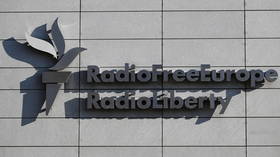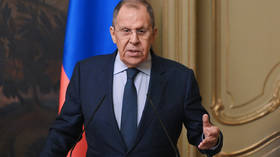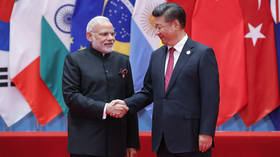No, Sweden, hand grenade attacks aren’t an ‘image’ problem
Stockholm was shaken by three explosions in one night last week. But the blasts didn’t even make headlines. With violence rising, the country’s government seems more concerned with downplaying the problem instead of tackling it.
Three explosions in one night would be front page news in any first-world city. But when Stockholm reverberated to multiple blasts in one night last week, national broadcaster SVT’s nightly broadcast was silent, relegating the news to its web coverage instead. One of the targets, a Syrian Orthodox church, had already been bombed twice in the past year.
But in Sweden, explosions no longer make the news. In 2018 there were 162 bombings reported to police, and 93 reported in the first five months of this year, 30 more than during the same period in 2018. The level of attacks is “extreme in a country that is not at war,” Crime Commissioner Gunnar Appelgren told SVT last year.
Also on rt.com At least 19 cars burned, barber shop rocked by EXPLOSION in Stockholm suburbThe use of hand grenades is a purely Swedish phenomenon too, with no other country in Europe reporting their use on such a level, a police manager told Swedish Radio in 2016, a year after attacks first spiked.
The grenades used almost exclusively originate in the former Yugoslavia, and are sold in Sweden for around $100 per piece. But while only three hand grenades were thrown in Kosovo between 2013 and 2014, more than 20 have been used in Sweden every year since 2015.
More broadly, homicide has risen in Sweden, with more than 300 shootings reported last year, causing 45 deaths. Though homicide rates had been in decline since 2002, they again began trending upwards in 2015, as did rapes and sexual assaults, which more than tripled in the last four years.
Of course, 2015 was also the year in which Sweden flung open its doors to more than 160,000 asylum seekers, more per capita than any other European country. The right have blamed these newcomers for the rising rates of homicide and sexual violence, and Denmark’s former Prime Minister Anders Fogh Rasmussen told Swedish television last year that he often uses “Sweden as a deterring example” of mass immigration gone wrong.
What would any country in the throes of a crime wave do? In Sweden’s case, the government and media have launched a concerted campaign to downplay the problem.
In February 2017, a month after a hand grenade was lobbed through the window of a police station in Katrineholm and days after another exploded in Södertälje, the Ministry of Foreign Affairs put out a press release debunking “simplistic and occasionally inaccurate information about migration, integration and crime in Sweden.” In it, gun crime was portrayed as a consequence of “criminal conflicts” and rising sexual violence attributed to a change in the definition of “rape” in Swedish law. The grenade attacks weren’t mentioned, and the claim that the government isn’t doing enough to stamp out crime was dismissed.
The publication rubbished the link between immigrants and crime. However, a recent study from the Swedish Defence University has warned that the Swedish justice system is ill-equipped to police the parallel societies developing in immigrant neighborhoods, and newspaper Dagens Nyheter pointed out that 90 percent of shooting perpetrators in Sweden are either first or second generation immigrants.
Also on rt.com Weaponized benefits: Ex-ISIS fighter abuses Swedish social security, demands $20K for UK jail timeSwedish police have identified 50 neighborhoods it considers “vulnerable” – a term many have taken as a euphemism for “no-go zones.” In tackling crime within them, the government has come up with some novel solutions, like implementing a ‘grenade amnesty’ last year, and kindly asking residents of violence-plagued Malmo to “stop shooting” each other.
Neither measure seems to have worked.
Still, the government would seemingly rather Sweden be associated with IKEA and social cohesion than immigrant gangs and grenade attacks. After all, admitting to the crime wave would undermine the supposed success of the Nordic model, and suggesting that it may be connected with immigration would call into question Sweden’s self-righteous status as a “humanitarian superpower,” as former Foreign Minister Margot Wallstrom described the country in 2015.
To that end, the government has not ordered a police crackdown in crime-stricken neighborhoods or held a national debate on integration. Instead it has launched a PR campaign to fix Sweden’s tarnished image abroad. The Swedish taxpayer funds the operation of the Swedish Institute to the tune of nearly $50 million per year. The institute is a sort of in-house PR agency that “promotes interest in Sweden around the world.”
Among its projects are English-language videos downplaying the country’s newfound reputation for crime, and the @sweden Twitter account, which spends its time literally telling critics “nothing has happened here in Sweden.”
No. Nothing has happened here in Sweden. There has not ben any terrorist attacks here. At all. The main news right now is about Melfest. ->
— @sweden (@sweden) February 19, 2017
You think that Swedish police have lost control? The ‘no-go zones’ are in fact ‘go-go zones’. #FactCheckpic.twitter.com/m0Aoi9lW59
— Sweden.se (@swedense) February 25, 2017
More than 14,000 journalists, authors and politicians have been blocked by @sweden for asking difficult questions, among them Israel’s ambassador to the country. However, the account’s curators reversed course when some online media kicked up a stink.
“The truth is that we are a country that gives the rest of the democratic world hope,” Deputy Prime Minister Isabella Lövin said last January, weeks after grenade attacks in Malmo, Stockholm and Gothenburg. In Stockholm, an elderly man died when he picked up an unexploded grenade near a metro station.
Meanwhile, with paramedics, firefighters and postmen refusing to serve high-crime immigrant neighborhoods, Prime Minister Stefan Löfven publicly denied the existence of ‘no-go zones’. Stockholm Police Chief Erik Åkerlund told Swedish Radio a year earlier that 50 neighborhoods identified by police as “vulnerable areas” were “more like ‘go-go zones.’”
Also on rt.com Woman shot dead after masked gunmen open fire on Swedish beachLess than a week after Åkerlund’s interview was aired, a man was hospitalized when a grenade ripped the facade of a house apart in Lindängen, a suburb of Malmo added to the list of "go-go zones" that year.
Call them what you will, but zones characterized by bombings, shootings, and an atmosphere that forbids essential services from entering without police escorts are no-go zones. Endemic bombings are the hallmark of countries at war, not countries that give “the rest of the democratic world hope.” And “humanitarian superpowers” should at bare minimum ensure their own citizens – native and immigrant – are protected against hand grenade attacks.
Sweden does not have an image problem. Sweden has a crime problem.
By Graham Dockery, RT
Think your friends would be interested? Share this story!
The statements, views and opinions expressed in this column are solely those of the author and do not necessarily represent those of RT.















